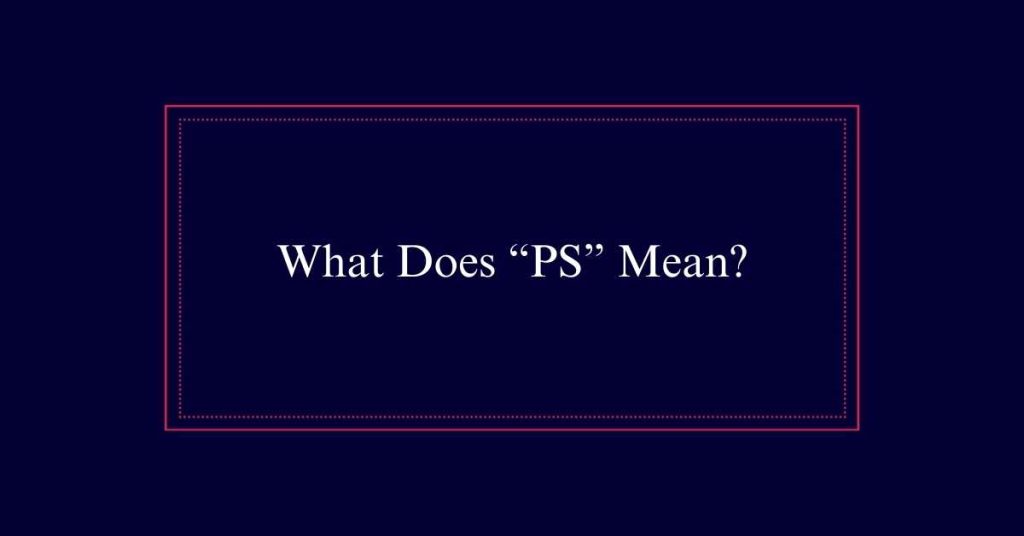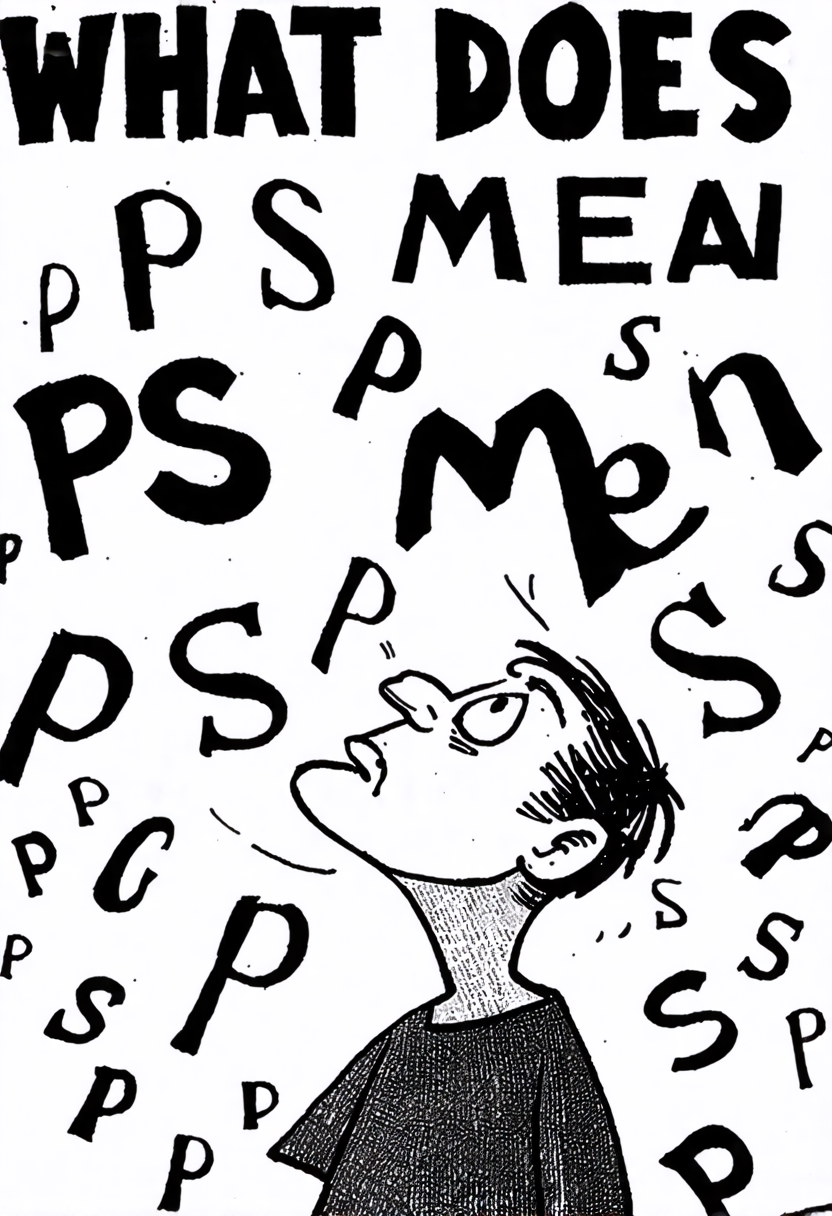What Does “PS” Mean?
“PS” stands for “postscript,” derived from the Latin “postscriptum.” Use it at the end of a letter or email to add a forgotten detail or emphasize a point. Always capitalize both letters and avoid using periods for a cleaner look. “PS” can add a personal touch or an important reminder, enhancing your message’s charm and impact. It’s especially effective in handwritten notes, making them feel warm and personal. In emails, it can boost engagement and response rates.
Meaning of ‘PS’
The abbreviation ‘PS’ stands for post script, which means additional information added at the end of a letter or message. It comes from the Latin phrase ‘postscriptum,’ meaning written after.
You use ‘PS’ to add anything you forgot or to make a point. In handwritten letters, people often used it for extra details or impact. Even today, ‘PS’ is popular in direct and email marketing to emphasize key points or add clever notes.
Authors like Shaun Usher consider it the most charming part of a letter. When you see ‘PS,’ it often grabs your attention and makes you read it. Adding a ‘PS’ can leave a lasting impression on your reader.

Origin of ‘PS’
‘PS’ has its roots in the Latin phrase ‘postscriptum.’ This means “written after.” In ancient times, people used ‘postscriptum’ to add extra thoughts after finishing a letter. They couldn’t simply edit their writing like we can now. So, adding a ‘PS’ was a practical solution.
Here’s a simple table to illustrate:
| Time Period | Writing Tool | Editing Method |
|---|---|---|
| Ancient Rome | Quill and Ink | Postscriptum |
| Middle Ages | Parchment | Postscriptum |
| Renaissance | Paper | Postscriptum |
| Industrial Age | Pen | Postscriptum |
| Modern Day | Keyboard | Backspace/Delete |
‘PS’ in Handwritten Letters
While ‘PS’ originated from ancient practices, its charm truly shines in handwritten letters. You can use ‘PS’ to add a personal touch or emphasize an afterthought. Here’s how it can make your letters special:
- Forgotten Details: Include something you remembered after finishing the main letter.
- Personal Touch: Share an intimate or humorous note that feels spontaneous.
- Emphasis: Highlight an important point you want the reader to remember.
- Warmth: Express affection or gratitude in a way that stands out.
Modern Usage of ‘PS’
In today’s digital age, you’ll find ‘PS’ still adding flair and emphasis to your emails and messages. Even with the ability to edit and revise electronic communications, using ‘PS’ can highlight important points or add a personal touch.
It stands out at the end, making it perfect for emphasizing significant information or adding a witty remark. Marketers often use ‘PS’ in email campaigns to engage readers and boost response rates. It’s a simple yet effective tool to catch attention.
You might use it to reiterate a key point, provide a subtle reminder, or share a last-minute thought. Whether for professional or personal messages, ‘PS’ remains a versatile and impactful way to communicate.
Capitalizing ‘PS’
When using ‘PS’ in your emails or letters, it’s important to know how to capitalize it correctly. Here are some key points to keep in mind:
- Always capitalize both letters: Write it as ‘PS’ to guarantee clarity and consistency.
- Avoid periods: While ‘P.S.’ is sometimes used, ‘PS’ without periods is widely accepted and looks cleaner.
- Place it correctly: Make sure ‘PS’ is at the end of your message, following your signature or closing remarks.
- Use it sparingly: Reserve ‘PS’ for adding something truly significant or an important afterthought.
Formatting ‘PS’
Formatting ‘PS’ correctly guarantees your message is clear and professional. Start by capitalizing ‘PS’ and decide if you want to use periods. In British English, ‘P.S.’ is common, while in American English, ‘PS’ without periods is also accepted. You can choose either; just stay consistent.
Place ‘PS’ at the end of your letter, after your signature. Leave a line space before ‘PS’ to make it stand out. Avoid trailing punctuation after ‘PS’ itself; start your message right away.
‘PS’ in Emails
You’ve got the formatting of ‘PS’ down, so let’s see how it plays a role in emails. Adding a ‘PS’ at the end can highlight key points or share an afterthought. It grabs attention and can make your message more engaging.
Here’s how you can use ‘PS’ effectively in emails:
- Emphasize a Key Point: Use ‘PS’ to restate an important detail.
- Add a Personal Touch: Share a small, personal note.
- Include a Call to Action: Encourage the reader to take a specific action.
- Highlight Special Offers: Mention discounts or promotions.
Marketing With ‘Ps’
Using ‘PS’ in marketing can boost engagement and make your message stand out. It’s a powerful tool to capture attention and reinforce your main points. A strategically placed ‘PS’ can prompt readers to take action, like clicking a link or making a purchase. Here’s a simple breakdown of how to use ‘PS’ in marketing:
| Purpose | Example |
|---|---|
| Call to Action | PS: Don’t miss our sale! |
| Highlight Offer | PS: Get 20% off today only! |
| Add Urgency | PS: Limited stock available. |
| Personal Touch | PS: Thanks for being a loyal customer! |
Famous ‘PS’ Examples
Famous figures like John Lennon, Ronald Reagan, Philip K. Dick, and Richard Feynman have all penned memorable ‘PS’ notes in their letters. These notes add a touch of personality and reveal hidden layers of their thoughts.
Here are some iconic examples:
- John Lennon: His witty ‘PS’ to a fan showcased his playful side.
- Ronald Reagan: He used ‘PS’ to give his son heartfelt advice on marriage.
- Philip K. Dick: Expressed excitement about his novel with an enthusiastic ‘PS’.
- Richard Feynman: In a love letter to his deceased wife, his ‘PS’ carried deep, emotional sentiments.
Impact of ‘PS
A well-placed ‘PS’ can add a personal touch and leave a lasting impression on the reader. It lets you emphasize key points or share extra thoughts. This small addition can make your message stand out.
Whether you’re writing a letter or an email, a ‘PS’ can highlight important information that might otherwise get overlooked. It also offers a chance to convey emotions or sentiments more intimately. Historical letters show how a ‘PS’ can enhance the overall tone and message, making the reader feel closer to the writer.
Use ‘PS’ to reinforce your main message, add charm, or share an afterthought. It’s a simple yet powerful tool in communication.







